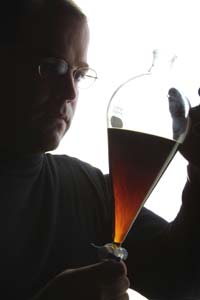Yet Another Benefit of Green Tea

holding a separator funnel containing the company’s environmentally friendly fluid used in ceramic polishing. <br><br>Credit: Erica von Koerber, Evon Photography (Tucson, Ariz.) <br><br>
New, biodegradable machining compound is more effective than industry standards
Derived in part from green tea, a new biodegradable machining compound for computer hard drive manufacturing is three to four times more effective than toxic counterparts. In an industry where more than 161 million hard drives leave assembly lines each year, the new compound could significantly improve manufacturing efficiency and minimize environmental risks.
Engineered by John Lombardi of Ventana Research Corporation in Tucson, Ariz., as part of a National Science Foundation (NSF) Small Business Innovation Research (SBIR) grant, the chemical is part of a slurry that polishes the ceramics—made from aluminum oxide and titanium carbide—used in computer hard drive read-write heads.
“The potential merits of this compound are impressive,” said James Rudd, the NSF program officer who oversees Ventana’s award. “If confirmed in industrial settings, the three- to four-fold increase in efficiency could mean substantial reductions in hard-drive manufacturing costs, and all with a product that is less corrosive and more environmentally sound.”
The new compound is part of a family of machining fluids that bind to polishing debris and rapidly remove tiny particles from the polishing surface. The fluids are critical because imperfections in read-write heads must be less than 10 angstroms high—larger defects can cause the head to crash into the disk, causing data loss.
Ventana formulates its fluid using a combination of synthetic proteins derived from common commercial chemicals and compounds extracted from green tea and other plants. Compared to many natural machining fluid compounds, which are often rare and expensive, the plant chemicals in the Ventana fluid are abundant and easily extractable.
Those chemicals, the same ones responsible for forming tenacious stains in coffee pots and drinking mugs, grant the Ventana fluid its ability to bind to the particle debris formed while polishing read-write heads.
According to Lombardi, the fluid’s possible biocompatibility and high affinity for ceramics and metals may lead to applications in wastewater treatment, where the compound could remove heavy metal contaminants from water, and medicine, where the compound may have advantages for delivering certain cancer treatments.
NSF awards SBIR grants to small businesses for risky, novel research with a potential for commercialization. Through SBIR and the related Small Business Technology Transfer (STTR) programs, NSF encourages partnerships between the small business and the academic sectors to develop a technology base for commercialization.
Comments from the researchers:
“South Tucson is a community currently lacking high technology manufacturing. Ventana was attracted to this location due to the friendly, cooperative and close-knit nature of this community, coupled with the fact that it is located within a designated U.S. Department of Housing and Urban Development Empowerment Zone. Both South Tucson and Tucson are among eight such zones established nationally.” – John Lombardi, president of Ventana Research Corporation.
“The engineering requirement for a computer magnetic read-write head is similar to flying a Boeing 747 jet airliner at full throttle a few inches above the ground.” – Donald Zipperian, Chief Technical Officer at Pace Technologies, Tucson, Ariz. Zipperian is an expert on the hard-drive manufacturing industry and a business collaborator of Ventana Research.
“The class of benign compounds synthesized by Dr. Lombardi has great potential for use in semiconductor cleaning and polishing operations. These compounds can serve as dispersants and corrosion inhibitors in slurries used for the chemical mechanical planarization of metals. They may also find use in chemical systems used for back-end of line cleaning processes.” – Srini Raghavan, Professor, Department of Materials Science and Engineering at the University of Arizona. Raghavan evaluated some of the properties of the fluid for Ventana Research. He is also involved in the NSF-SRC Center for Environmentally Benign Semiconductor Manufacturing at the University of Arizona, where he is planning to evaluate the compounds in his research projects.
Media Contact
More Information:
http://www.nsf.gov/od/lpa/newsroom/pr.cfm?ni=80All latest news from the category: Process Engineering
This special field revolves around processes for modifying material properties (milling, cooling), composition (filtration, distillation) and type (oxidation, hydration).
Valuable information is available on a broad range of technologies including material separation, laser processes, measuring techniques and robot engineering in addition to testing methods and coating and materials analysis processes.
Newest articles

Superradiant atoms could push the boundaries of how precisely time can be measured
Superradiant atoms can help us measure time more precisely than ever. In a new study, researchers from the University of Copenhagen present a new method for measuring the time interval,…

Ion thermoelectric conversion devices for near room temperature
The electrode sheet of the thermoelectric device consists of ionic hydrogel, which is sandwiched between the electrodes to form, and the Prussian blue on the electrode undergoes a redox reaction…

Zap Energy achieves 37-million-degree temperatures in a compact device
New publication reports record electron temperatures for a small-scale, sheared-flow-stabilized Z-pinch fusion device. In the nine decades since humans first produced fusion reactions, only a few fusion technologies have demonstrated…





















